
Rocky Mountain spotted fever (RMSF) is a bacterial disease spread by ticks. It typically begins with a fever and headache, which is followed a few days later with the development of a rash. The rash is generally made up of small spots of bleeding and starts on the wrists and ankles. Other symptoms may include muscle pains and vomiting. Long-term complications following recovery may include hearing loss or loss of part of an arm or leg.

Ticks are parasitic arachnids that are part of the mite superorder Parasitiformes. Adult ticks are approximately 3 to 5 mm in length depending on age, sex, species, and "fullness". Ticks are external parasites, living by feeding on the blood of mammals, birds, and sometimes reptiles and amphibians. The timing of the origin of ticks is uncertain, though the oldest known tick fossils are from the Cretaceous period, around 100 million years old. Ticks are widely distributed around the world, especially in warm, humid climates.
Ehrlichiosis is a tick-borne disease of dogs usually caused by the rickettsial agent Ehrlichia canis. Ehrlichia canis is the pathogen of animals. Humans can become infected by E. canis and other species after tick exposure. German Shepherd Dogs are thought to be susceptible to a particularly severe form of the disease; other breeds generally have milder clinical signs. Cats can also be infected.

The Ixodidae are the family of hard ticks or scale ticks, one of the three families of ticks, consisting of over 700 species. They are known as 'hard ticks' because they have a scutum or hard shield, which the other major family of ticks, the 'soft ticks' (Argasidae), lack. They are ectoparasites of a wide range of host species, and some are vectors of pathogens that can cause human disease.

Babesiosis or piroplasmosis is a malaria-like parasitic disease caused by infection with a eukaryotic parasite in the order Piroplasmida, typically a Babesia or Theileria, in the phylum Apicomplexa. Human babesiosis transmission via tick bite is most common in the Northeastern and Midwestern United States and parts of Europe, and sporadic throughout the rest of the world. It occurs in warm weather. People can get infected with Babesia parasites by the bite of an infected tick, by getting a blood transfusion from an infected donor of blood products, or by congenital transmission . Ticks transmit the human strain of babesiosis, so it often presents with other tick-borne illnesses such as Lyme disease. After trypanosomes, Babesia is thought to be the second-most common blood parasite of mammals. They can have major adverse effects on the health of domestic animals in areas without severe winters. In cattle, the disease is known as Texas cattle fever or redwater.

Rickettsia rickettsii is a Gram-negative, intracellular, coccobacillus bacterium that was first discovered in 1902. R. rickettsii is the causative agent of Rocky Mountain Spotted Fever and is transferred to its host via a tick bite. It is one of the most pathogenic Rickettsia species and affects a large majority of the Western Hemisphere, most commonly the Americas.

Dermacentor variabilis, also known as the American dog tick or wood tick, is a species of tick that is known to carry bacteria responsible for several diseases in humans, including Rocky Mountain spotted fever and tularemia. It is one of the best-known hard ticks. Diseases are spread when it sucks blood from the host. It may take several days for the host to experience symptoms.
A canine vector-borne disease (CVBD) is one of "a group of globally distributed and rapidly spreading illnesses that are caused by a range of pathogens transmitted by arthropods including ticks, fleas, mosquitoes and phlebotomine sandflies." CVBDs are important in the fields of veterinary medicine, animal welfare, and public health. Some CVBDs are of zoonotic concern.

Ehrlichiosis is a tick-borne bacterial infection, caused by bacteria of the family Anaplasmataceae, genera Ehrlichia and Anaplasma. These obligate intracellular bacteria infect and kill white blood cells.
Ehrlichia chaffeensis is an obligate intracellular, Gram-negative species of Rickettsiales bacteria. It is a zoonotic pathogen transmitted to humans by the lone star tick. It is the causative agent of human monocytic ehrlichiosis.

Ehrlichia ewingii is a species of rickettsiales bacteria. It has recently been associated with human infection, and can be detected via PCR serological testing. The name Ehrlichia ewingii was proposed in 1992.
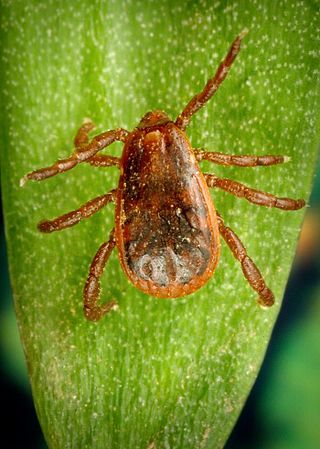
Rhipicephalus is a genus of ticks in the family Ixodidae, the hard ticks, consisting of about 74 or 75 species. Most are native to tropical Africa.
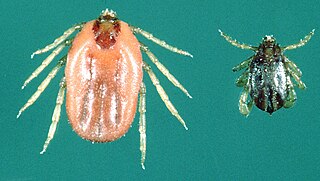
The Asian blue tick is an economically important tick that parasitises a variety of livestock species especially cattle, on which it is the most economically significant ectoparasite in the world. It is known as the Australian cattle tick, southern cattle tick, Cuban tick, Madagascar blue tick, and Puerto Rican Texas fever tick.
Ehrlichia canis is an obligate intracellular bacterium that acts as the causative agent of ehrlichiosis, a disease most commonly affecting canine species. This pathogen is present throughout the United States, South America, Asia, Africa and recently in the Kimberley region of Australia. First defined in 1935, E. canis emerged in the United States in 1963 and its presence has since been found in all 48 contiguous United States. Reported primarily in dogs, E. canis has also been documented in felines and humans, where it is transferred most commonly via Rhipicephalus sanguineus, the brown dog tick.

Ticks of domestic animals directly cause poor health and loss of production to their hosts. Ticks also transmit numerous kinds of viruses, bacteria, and protozoa between domestic animals. These microbes cause diseases which can be severely debilitating or fatal to domestic animals, and may also affect humans. Ticks are especially important to domestic animals in tropical and subtropical countries, where the warm climate enables many species to flourish. Also, the large populations of wild animals in warm countries provide a reservoir of ticks and infective microbes that spread to domestic animals. Farmers of livestock animals use many methods to control ticks, and related treatments are used to reduce infestation of companion animals.

Babesia canis is a parasite that infects red blood cells and can lead to anemia. This is a species that falls under the overarching genus Babesia. It is transmitted by the brown dog tick and is one of the most common piroplasm infections. The brown dog tick is adapted to warmer climates and is found in both Europe and the United States, especially in shelters and greyhound kennels. In Europe, it is also transmitted by Dermacentor ticks with an increase in infections reported due to people traveling with their pets.

Rhipicephalus annulatus, the cattle tick, is a hard-bodied tick of the genus Rhipicephalus. It is also known as North American cattle tick, North American Texas fever tick, and Texas fever tick.
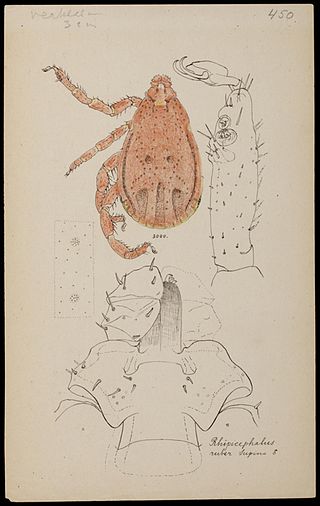
Rhipicephalus haemaphysaloides is a hard-bodied tick of the genus Rhipicephalus. It is one of the major medically important ticks in the world.
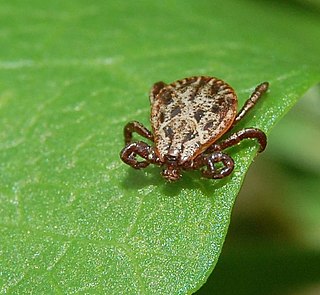
Dermacentor reticulatus, also known as the ornate cow tick, ornate dog tick, meadow tick, and marsh tick, is a species of tick from the family Ixodidae. It is the type species for the genus Dermacentor. D. reticulatus is an ornate tick. The female varies in size from 3.8–4.2 mm (unfed) to 10 mm when engorged after feeding. The unfed male is 4.2–4.8 mm long. D. reticulatus is found in Europe and Western Asia, generally in wooded areas.
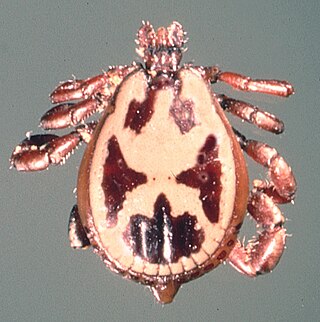
The zebra tick or yellow back tick is a species of hard tick. It is common in the Horn of Africa, with a habitat of the Rift Valley and eastward. It feeds upon a wide variety of species, including livestock, wild mammals, and humans, and can be a vector for various pathogens. The adult male has a distinctive black and ivory ornamentation on its scutum.















